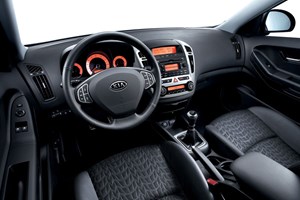
Kia Proceed
| How much? | £12,295 |
|---|---|
| On sale in the UK: | Now |
| Engine: | 1991cc 4-cyl 16v turbodiesel, 138bhp @ 4000rpm, 225lb/ft @ 1800-2500rpm |
| Transmission: | Five- or six-speed manual, front-wheel drive (four-speed auto also available) |
| Performance: | 10.1sec 0-62mph, 127mph, 50.4mpg, 149 g/m CO2 |
| How heavy / made of? | 1499 kg/steel |
| How big (length/width/height in mm)? | 4250/1790/1450 |
Stupid names for cars aren’t new. We’re had the Nissan Gloria, the Ford Probe and the Mazda Bongo Brawny van after all. But in the long roll call of daft designations, the Kia pro_cee’d (note the lower case ‘p’, the underscore and apostrophe) takes top prize. The pro_cee’d is the three-door sportier version of the cee’d, the new European-built Kia five-door hatch.
The cee’d name, should you be wondering, comes from the car’s French designer (Gregory Guillaume) who – mindful that this is a European designed and built car – decided on calling it after the French for EEC: CEE. Then he added ED (for European Design). Because ceeed would have been an even stupider name, the enterprising Guillaume apostrophised it to cee’d. And the ‘pro’ bit for the new three-door variant? Well that just sounded good, or so someone thought. So to what is probably the least desirable car brand in Britain – Kia – add probably the daftest model name. Brilliant.
OK but is it any good?
Yes it is. Forget about all those horrible old Kias of a few years ago (and even the new Korean-built ones have price as their main virtue). The cee’d hatch and this new model, the three-door pro_cee’d, are European standard cars in all but name. Designed by Kia in Germany, built by Kia in a high-tech factory in Slovakia.
The Proceed (can we forget about all the crazy punctuation please?) looks good in a slightly Euro-derivative way (think three-door Astra but with a bit less jewellery). It’s lower and longer than a cee’d; only the bonnet and front wings are borrowed. Proportions are excellent, stance is good. Build quality is also first rate. And the cabin is minimalist mix of nicely tactile plastics and alloy trim. It’s one of the nicest interiors in the Golf-sized hatch class. A first for a Korean car.
What are the engines?
Carry over (from the cee’d) 1.6 petrol and 1.6 turbodiesel and, new for the Proceed, a 2.0-litre turbodiesel (borrowed from the Sportage 4x4, also built in Slovakia). Both 1.6 units are sweet revving and gutsy. Avoid the sportiest engine, the 2.0D. It’s loud and crude.
The 1.6 diesel is the newest engine and the pick. But if your budget can just stretch to the entry level 1.6 pro_cee’d2 (more crazy punctuation!) – a bargain at £12,295 – then smile. The cheapest Proceed is a sweet little thing, willing and smooth riding. (An even cheaper 1.4 Proceed is coming soon, at £11,795.)
But can a cheap hatchback Kia be fun to drive?
It’s no Focus. But it’s not too far behind. The electric power steering is a bit lifeless and you won’t be throwing this car around the twisties for the fun of it (like you might a Focus). But it is extremely capable and the ride is good if a little firm. It’s a perfectly pleasant and appealing car.
So is this a first? A Korean car that you’re recommending?
Yes, the Proceed is a really capable car, good looking, decent to drive, well equipped (air-con and iPod jack are standard) and well made. It’s not just the best Korean car on sale today, it’s also one of the most pleasant small hatches available in Britain. And, most appealing of all, it undercuts similar-spec similar-standard hatches by £2000-£4000 and has a seven-year warranty.
CAR's rating
Handling
Performance
Usability
Feelgood factor
Readers' rating



































